Call us FREE 0808 2394 989
Opening Hours - Office closed, we'll open at 8:30am
Call us FREE 0808 2394 989
Opening Hours - Office closed, we'll open at 8:30am

From the grandeur of the Palace of Versailles to the remarkable structure of the Leaning Tower of Pisa, our guide is the perfect introduction to European architecture
Published on 13 Oct 2021
From the dramatic spires of Notre Dame to the fascinating history of the Leaning Tower of Pisa, there’s so much to learn from European architecture. If you need help telling Romanesque from Renaissance, take a look at this handy guide to some of Europe’s most iconic architecture.
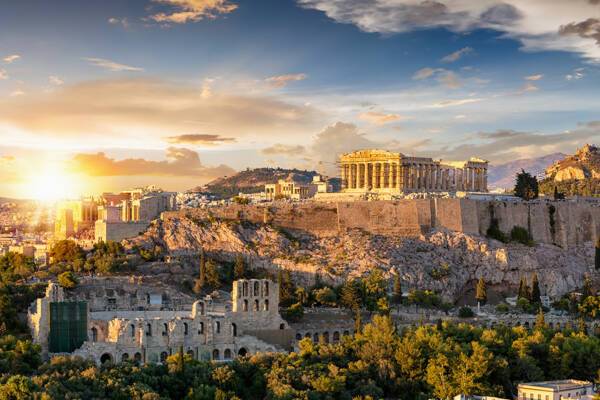
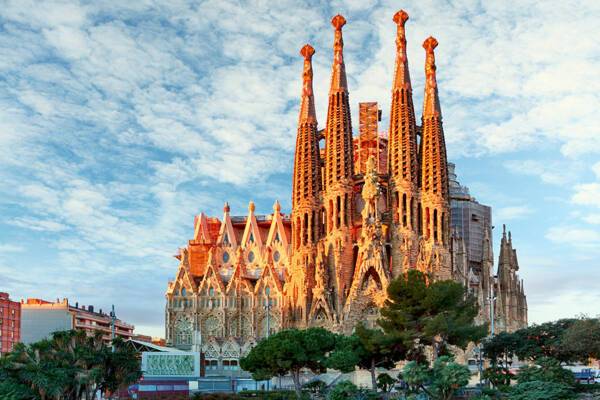
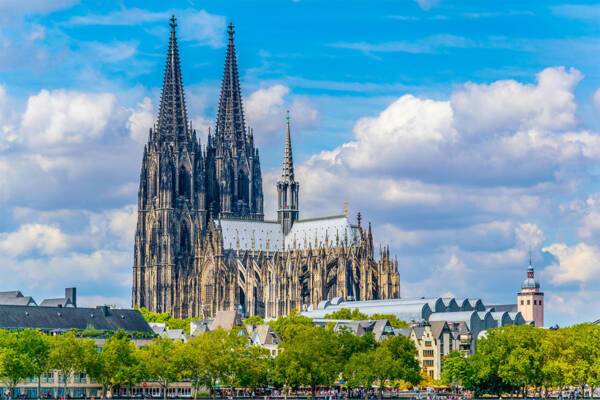
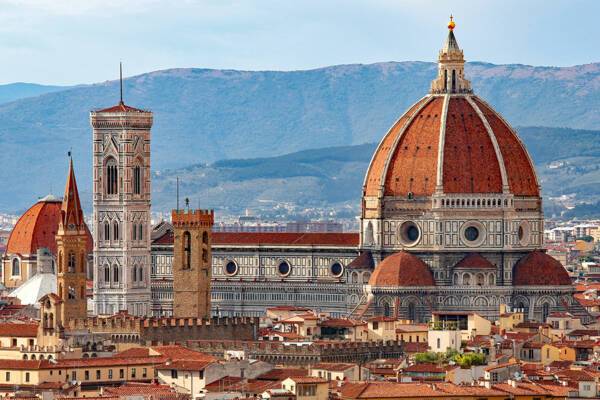
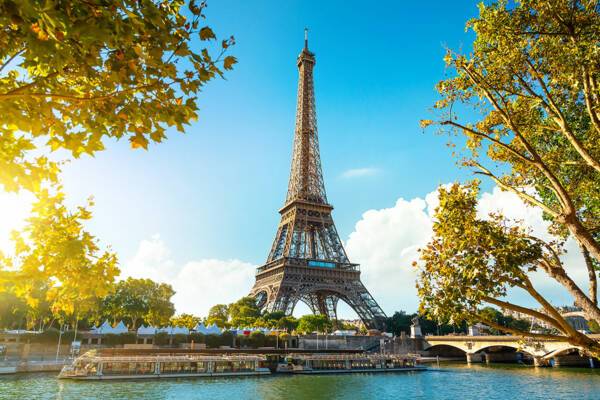
Build began: 5th century BC
Architectural style: Ancient Greek - Doric, Ionic, Corinthian orders. Doric order is the least extravagant form of Ancient Greek architecture: the columns have no base and were not ornately decorated. Ionic order architecture is slightly more decorative with taller and thinner columns and ornate bases. Corinthian order architecture is similar to Ionic but the capitals (tops of columns) are even more ornate, decorated with designs such as leaves or floral patterns.
Similar examples: The Colosseum and the Pantheon in Rome.
History: Planning and initial construction began under the guidance of the general and statesman Pericles of Athens. The first stone was laid on July 28th 447 BCE. The intention was to create a lasting monument to honour the goddess Athena and proclaim the glory of the city to the world. Pericles hired skilled architects and the sculptor Phidias, who created the statue of Zeus at Olympia. Over the years, hundreds of artisans, metal workers, craftspeople, painters, woodcarvers and thousands of unskilled labourers worked on the Acropolis.
Other buildings were added to the Acropolis by Roman Emperor Hadrian and with the rise of Christianity after Constantine the Great, the Pantheon became a church and the Acropolis was made into a centre of Christian devotion. After the fall of Rome in the West in 476 CE, and the Byzantine Empire in the east, the Acropolis was transformed into a Muslim place of worship. Many wars and varying occupations of this ancient structure meant the Acropolis was severely damaged over time. In the twentieth century, serious restoration and preservation work was carried out. This is still going on today to preserve the Acropolis.
Did you know? The word ‘Acropolis’ derives from the Greek word ‘Akro,’ which means high or extreme/extremity or edge, and ‘Polis,’ which translates to ‘high city,’ ‘city on the edge’ or ‘city in the air.’
Visiting today: If you’re visiting in the summer, be sure to explore the site early or late in the day to avoid the heat. Part of the reason the Acropolis is so spectacular is its views over Athens, so prepare for a fair amount of uphill walking. Visit the museum to see ancient artefacts or take a guided tour to learn more as you wander through this UNESCO World Heritage site.
Build began: 1882
Architectural style: A unique design by Antoni Gaudí, influenced by Gothic and Art Nouveau architecture. Typical features of Art Nouveau architecture include geometric motifs and strong colours.
Similar examples: Musée Horta in Brussels and Lavirotte Building in Paris.
History: Sagrada Família was the inspiration of a bookseller, Josep Maria Bocabella. He founded the Spiritual Association of Devotees of St. Joseph and, funded by donations, began by building the apse crypt of the church with architect Francisco de Paula del Villar. In 1883, when Villar resigned, Gaudí resumed work on the church in a completely different style. When Gaudí died in 1926, the cathedral was only around 20% complete. Work has continued under the guidance of many people over the years and is still not complete. When it is finished, it will be the tallest religious building in Europe.
Did you know? Gaudí was killed after being hit by a tram and his tomb is within Sagrada Família.
Visiting today: Although many areas of the building are still under construction, Sagrada Família welcomes over 2.8 million visitors every year. The profits generated by ticket sales go towards continuing the build, so you’re helping the construction of this masterpiece when you visit!
Build began: 1248
Architectural style: Gothic style architecture. Typical features of Gothic architecture include pointed arches, gargoyles and clustered columns.
Similar examples: Westminster Abbey in London and Notre Dame in Paris.
History: Cologne Cathedral was not the first structure to be erected on the site. It is believed the ground was previously home to a Roman temple. However, from the fourth century onwards, the site has been occupied by Christina buildings. One, a free-standing baptistery dating back to the sixth century, was at one stage part of the present Cologne Cathedral. But it was demolished in the ninth century to make room for the second cathedral. You can still see ruins of the old baptistery today.
The foundation stone of the cathedral was laid in August 1248 by Archbishop Konrad von Hochstaden. The eastern arm was completed under the direction of Master Gerhard and consecrated in 1322. Today, 84 misericords (also known as mercy seats) remain from this period of the build. In 1473, work paused, leaving the south tower incomplete at the top near the bell tower. A huge crane remained at the top of the cathedral for 400 years.
Work resumed in the nineteenth century after the discovery of the original plan for the façade. Work on Germany’s largest cathedral was completed at a celebratory event in August 1880. Sadly, during World War II, the cathedral was badly damaged. Having been carefully maintained, Cologne Cathedral was given UNESCO World Heritage status in 1996.
Did you know? The cathedral’s twin spires were used as a navigational landmark for aircraft during World War II.
Visiting today: Cologne cathedral attracts around 20,000 visitors every day and is open all year round. Visitors can climb to the tower to get spectacular views over the 2,000-year-old city.
Build began: 1296
Architectural style: Gothic/Renaissance architecture. Features of Gothic architecture include pointed arches, flying buttresses and vaulted ceilings. Renaissance architecture often includes orderly arrangements of columns, semi-circular arches and domes, with a focus on symmetry and geometry.
Similar examples: Milan Cathedral in Milan, Louvre in Paris and St. Peter’s Basilica in Rome.
History: Florence Cathedral (or Santa Maria del Fiore) is an iconic site which was consecrated (officially declared a church) by Pope Eugenius IV in March 1436. Its initial designer, Arnolfo di Cambio, wanted it to be the world’s largest church of the Roman Catholic faith. One of the cathedral’s most famous features is its dome which was designed by Renaissance architect Filippo Brunelleschi. He was inspired by the engineering style used to build Rome’s Pantheon, another iconic example of European architecture.
Did you know? Florence Cathedral is the fourth largest in the world after St. Peter’s in Rome, St. Paul’s in London and the cathedral in Milan. See Florence’s fantastic architecture for yourself by taking a Mediterranean cruise via the port of Livorno.
Build began: 1887
Architectural style: The Eiffel Tower’s unique, industrial design was initially criticised by leading artists.
History: To mark the 100-year anniversary of the French Revolution, Paris hosted an Exposition Universelle (or World’s Fair). More than 100 artists submitted plans for a monument to be built on the Champ-de-Mars in the centre of Paris, but it was Eiffel et Compagnie, a construction firm led by builder and architect Alexandre-Gustave Eiffel, that won the project. It was actually Eifell’s employee, structural engineer Maurice Koechlin, who came up with the idea for the tower. It took two years to assemble the framework for the iconic tower, which, at the time of unveiling in 1889, was the tallest structure in the world. The Eiffel Tower held this title until 1930 (at which point the Chrysler Building in New York City overtook it).
As it was intended to be a temporary exhibit, the tower was almost torn down in 1909. City officials stepped in to save it after recognising its value as a radiotelegraph station. During World War I, the Eiffel Tower intercepted enemy radio communications. The fate of the tower was threatened again by Adolf Hitler, who ordered the demolition of Paris’ iconic symbol. But this never materialised.
Did you know? To keep the structure looking young, the Eiffel Tower is painted every seven years - this uses a huge 60 tonnes of paint every time!
Visiting today: You can reach the top level of the Eiffel Tower using lifts or stairs if you want to get a closer look at the structure. There are 704 steps to the top, but you’ll be rewarded with panoramic views over Paris.
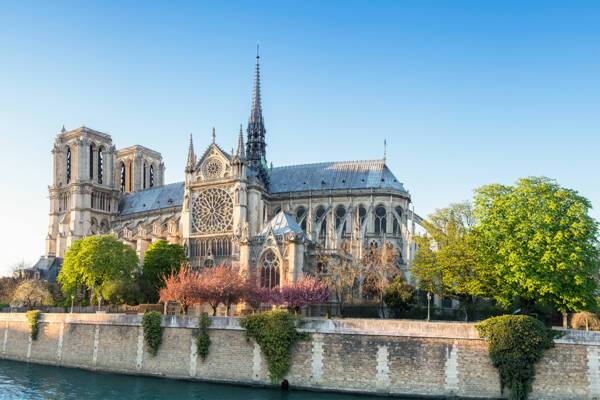
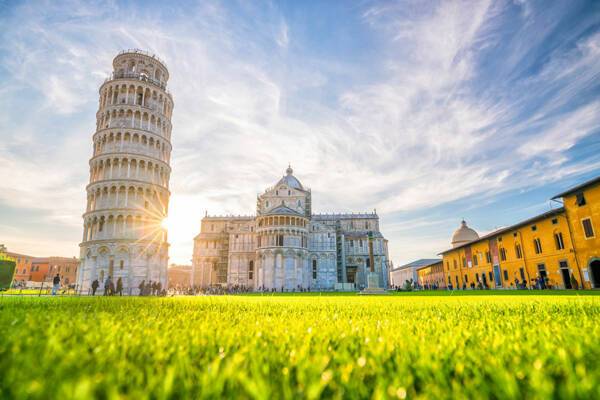
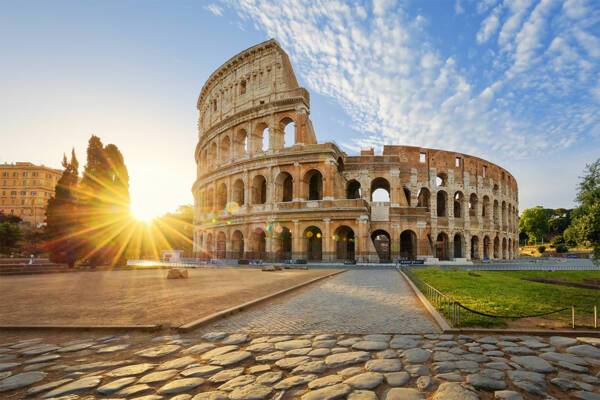
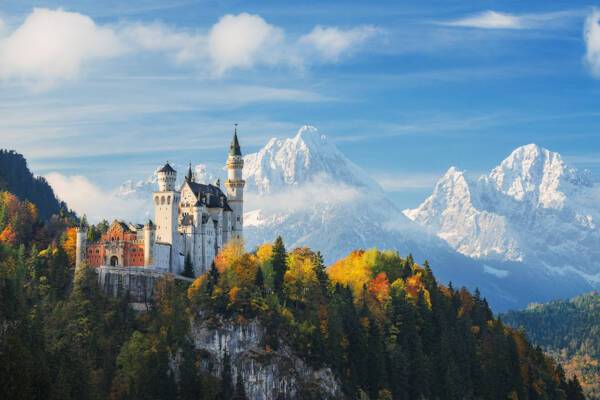
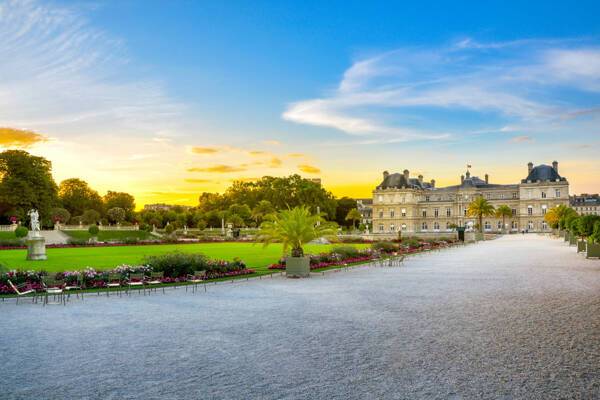
Build began: 1163
Architectural style: Medieval/Gothic architecture. Features of medieval gothic architecture include gargoyles, pointed arches, clustered columns and sharply pointed spires.
Similar examples: Westminster Abbey in London and Cologne Cathedral in Germany.
History: The Notre Dame Cathedral or Notre Dame de Paris, meaning ‘our lady of Paris’ in French, is a stunning cathedral. It was one of the world’s first Gothic cathedrals and took over 300 years to build. Its architectural styles vary in some parts, reflecting the length of time taken to complete this imposing structure. The cathedral suffered severe damage during the French Revolution in 1786 and a structural fire in 2019.
Did you know? In 1909 Joan of Arc was beatified (blessed) in the Notre Dame Cathedral by Pope Pius X. She told people she had experienced visions from God and went on to assist the French in conflicts with English soldiers. The French trusted her word and won many battles against England.
Visiting today: Notre Dame is a Catholic church and is free to visit. Each day throughout the year you can visit and learn about the cathedral in different languages on a guided tour.
Build began: 1173
Architectural style: Medieval architecture in Romanesque style. Typical features of Romanesque architecture include large towers, decorative arcading, thick walls and round arches.
Similar examples: San Gimignano in Italy and Durham Cathedral in the UK.
History: Construction of the Tower of Pisa began in August 1173, but it wasn’t completed until 1399. It was originally designed to be a bell tower and stood upright for around five years before it began to lean. The foundation of the tower is only three metres deep, built on a dense clay mixture. Construction was halted for 100 years, during which time the government hoped the soil would settle and strengthen the tower’s foundations. After a century, Giovanni di Simone began to add four more floors to the tower but only caused it to lean further when he tried to fix the problem by making one of the upper floors taller than the other.
Did you know? The seven bells at the top of the monument have not rung since the twentieth century because restorers are worried the movement of the heavy bells will make the tower lean even more.
Visiting today: The Leaning Tower of Pisa has been stabilised with 800 tonnes of leaden counterweight at its base. It has been open to tourists since 2001 and you can even climb to the top of the tower. It’s recommended that you book tickets to climb the tower in advance, as this is a popular activity in the city.
Build began: 72 AD
Architectural style: Ancient Roman/Classical architecture. This architectural style can be split into “orders:” Doric, Ionic and Corinthian, similar to the Acropolis of Athens. Its ground-floor half columns are a Roman variation of the Doric order, the semi-columns on the second floor are Ionic, while on the third floor, the columns are Corinthian.
Similar examples: Acropolis of Athens, Greece.
History: When Emperor Vespasian took the throne in 69 AD, he pledged to tone down the excesses of the Roman court. He returned the lush land at the centre of Rome (where Nero had built a great palace for himself) to the Roman people. On this site, Vespasian announced he would build a new amphitheatre in which the public could watch gladiatorial combats and other entertainment.
With the help of his sons, Titus and Domitian, Vespasian built the Colosseum. It took nearly a decade to complete and Rome celebrated the grand opening with a festival of 100 days of games. Titus earned the people’s devotion after his handling of recovery efforts following the eruption of Mount Vesuvius in 79 AD and the Colosseum was completed under the reign of his successor and brother, Domitian.
This epic structure had seating for more than 50,000 people. Spectators enjoyed gladiatorial combats, wild animal fights and even fake naval engagements, for which the Colosseum was filled with water. It was used over the next four centuries until the downfall of the Western Roman Empire and a lack of interest from the public put an end to the brutal entertainment.
Did you know? The Colosseum is the largest amphitheatre in the world.
Visiting today: The Colosseum is open all year round, except for 1st January and 25th December. It is the most popular landmark in Italy, so be sure to allow plenty of time to get into the amphitheatre in the summer.
Build began: 19th century
Architectural style: Romanesque revival architecture. Common features include round towers with cone-shaped roofs, low arches over arcades and doorways and columns and pilasters with spirals and leaf designs.
Similar examples: Neuschwanstein Castle was largely inspired by Hohenschwangau Castle in southern Germany.
History: Neuschwanstein Castle war originally commissioned by King Ludwig II of Bavaria as a retreat and homage to composer Richard Wagner. Unlike many other iconic European landmarks, it is believed Ludwig paid for the palace with his personal fortune, rather than Bavarian public funds. The King found inspiration for the castle from two journeys in 1867, one to the reconstructed Wartburg Castle and another to the Château de Pierrefonds. He saw both as representatives of a romantic interpretation of the Middle Ages and, combined with his admiration for Richard Wagner’s works, this inspired Neuschwanstein.
The original plans, which would have incorporated the ruined castle of Vorderhohenschwangau, were rejected due to technical reasons and replaced instead by grander plans for a palace modelled on Wartburg. It is said that the king was so heavily involved in every step of the construction that the castle has been referenced as his own creation.
The ruins of the previous medieval castles were demolished in 1868 and, by 1884, the king moved into the unfinished castle. For decades the site employed around 200 craftsmen in addition to suppliers and other workers. It is believed that over 465 tonnes of Salzburg marble, 1500 tonnes of sandstone and 400,000 bricks were used. By the time of his death in 1886, Ludwig’s creation was still not complete. He had never intended for the palace to be accessible to the public, but not only six weeks after his death, regent Luitpold ordered that the castle be opened to paying visitors.
Did you know? The castle inspired Walt Disney’s iconic Cinderella Castle.
Visiting today: Neuschwanstein Castle is accessed via a path, which begins in the nearby village of Hohenschwangau. The walk takes around 30 minutes from the ticket centre and is somewhat hilly. There’s also a shuttle bus to take visitors close to the castle, which reduces the walk. Surrounded by the lush green hills and mountains of Bavaria, the castle is set in a magical location.
Build began: 1623
Architectural style: French Baroque. Features of this style include elaborate ornate decoration, ceiling frescoes and dramatic use of light.
Similar examples: Trevi Fountain in Rome and St. Paul’s Cathedral in London.
History: The palace was first built by Louis XIII as a hunting lodge of brick and stone but it was enlarged into a royal palace by Louis XIV. The first phase of the expansion was designed and supervised by architect Louis Le Vau. Over the years, numerous wings, fountains, gardens and features were added by various architects. This included a grand canal in the west of the garden, used for naval demonstrations and gondolas opulent fountains and sculptures. It is estimated that 60% of France’s revenue was spent on this extravagant building, roughly £1.6 billion in today’s currency.
During the French Revolution, the royal family was forced to move to Paris, three years before the fall of the monarchy. The Palace of Versailles was neglected and most of the furniture was sold. Napoleon undertook some restoration work on the palace in 1810, as did Louis XVIII. But the most dedicated effort to maintain Versailles was made by King Louis-Philippe.
At the far end of the northern canal section, the Trianon Estate was built as a more intimate space near the palace. This part of the estate is most closely associated with Queen Marie-Antoinette, the wife of Louis XVI. It is thought she was responsible for commissioning the landscaped gardens and adding unusual features such as a ‘Temple of Love’ and a cave structure with a moss bed.
Did you know? The Hall of Mirrors features 357 mirrors, aligned with windows to create a sense of symmetry.
Visiting today: Most of the palace is open to visitors, but you can also get passes to see the musical fountains show and musical gardens. The Versailles Estate is also open and free of charge to visitors on the first Sunday of the month from November to March.